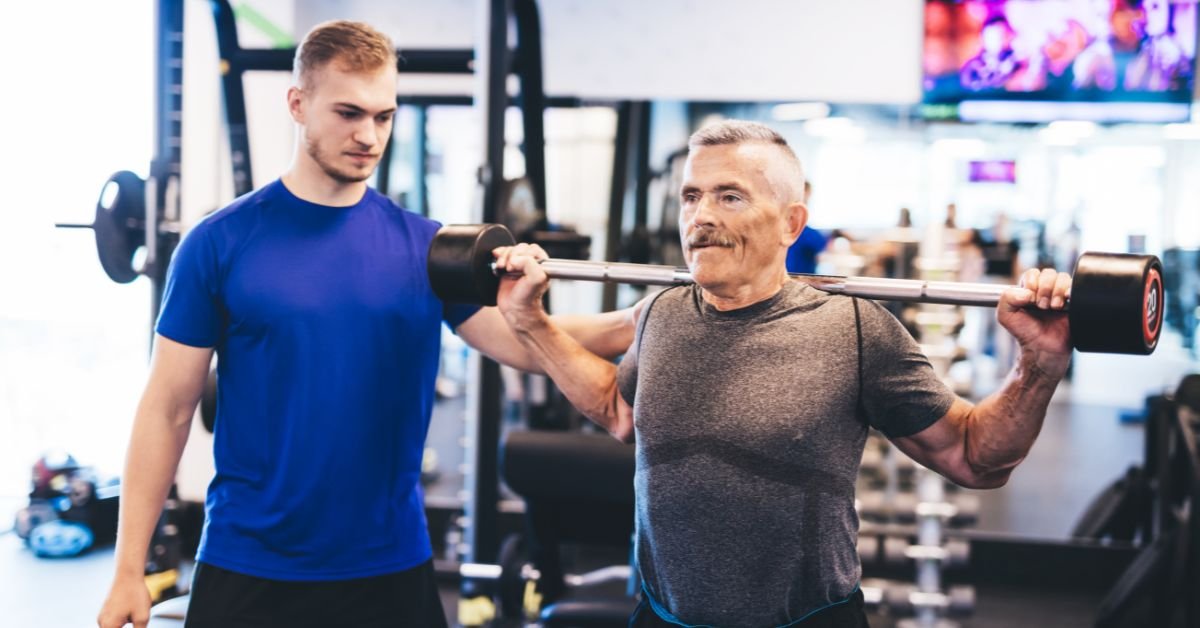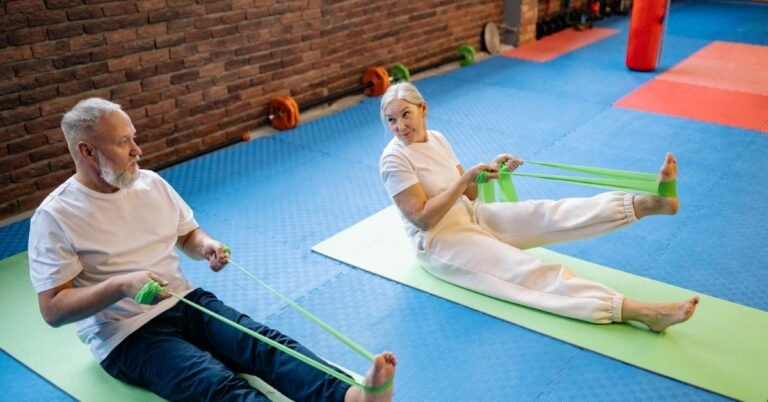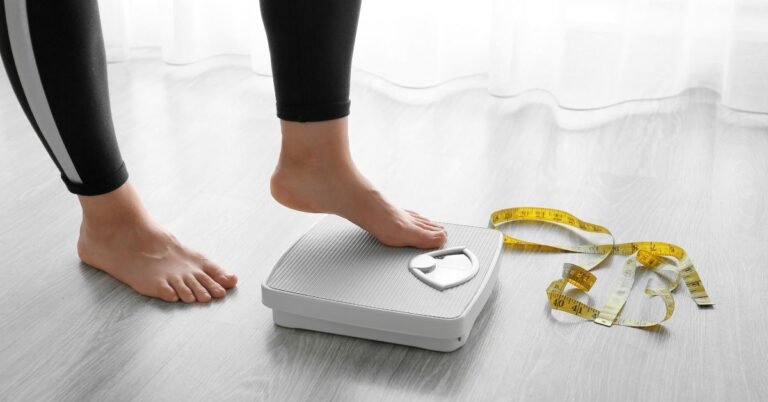Are you an older adult looking to learn more about strength training? It’s never too late to begin!
For some seniors, just the thought of walking over to the weights area in the gym is enough to put them off the idea completely. Add to this, all the new terminology to get your head around, such as ‘load’ ‘resistance’ and ‘overload’. It can all feel overwhelming.
Strength training does not need to be scary or complicated. It can be as easy as performing some simple exercises in your own home, and it can be done by anyone, at any age.
There are just a few key basic principles that need to be understood in order to do it safely and effectively. We’ll cover all of these below in our ultimate guide to strength training for older adults.
What we’ll cover:
What is strength training?
According to the NHS, strength exercises are “any activity that makes your muscles work harder than usual. This increases your muscles’ strength, size, power and endurance.”
So strength training (resistance training) is the process of carrying out these exercises, using either your body weight or working against an external resistance (load). The more you increase the resistance, the harder your muscles have to work.
What are the different types of strength training?
There are many different ways to strengthen your muscles. All you need is some form of external resistance or load which challenges your muscles. Then you need to keep challenging them consistently.
Bodyweight Workouts
For beginners, bodyweight workouts are the place to start in strength training. It will help you to learn and practice the key movement patterns your muscles need to perform. Bodyweight workouts also mean you don’t have to go to a gym or use any fancy equipment, they can be done anywhere!
Think of movements such as going from sitting to standing from a chair and stepping up onto a step. These can then be adapted to make them more challenging. Whatever your age, you can get very strong from bodyweight training by progressing the exercises.
For example, these are some different progressions of a press up:
- Against the wall
- Leaning onto a table or lower surface
- Progress to a press up on the floor, on your knees
- A full press up
Next you might want to start thinking about adding in some resistance or load. This can be any form of weight. Household objects are a good start. Think: cans of beans, water bottles, books etc.
When you’re ready for a bit more weight, you might have to start investing in some equipment, or joining a local gym to use their equipment.
Dumbbells
Dumbbells are also great for beginners. They aren’t scary, they are easy to hold, they don’t take up much room and they are an easy way to start tracking your progress. You can hold dumbbells to add resistance to many different movements.
For example, you can start to hold a set of dumbbells whilst you sit to stand from a chair. Or when you squat, lunge or press your hands in the air.
Kettlebells
Kettlebells are similar – you just hold them slightly differently. Again, they can be used to progressively add weight to lots of different movements. They are easy to handle and work with and would not take up much room at home. Or, you will be able to find these at your local gym.
Resistance Machines
If you are braving it in the gym, resistance machines are another ideal option. They are very safe (as everything is fixed in place), it’s easy to adjust the resistance and you can work on specific muscle groups. Often, you’ll find that the machines have a description and a picture showing you how to use them.
Barbell
Finally, we have the barbell. For anybody serious about getting strong, whatever your age, gender or current level of strength, this will be an essential piece of equipment to start using. Many people start with pre-loaded barbells; these are the ones with the weight of the bar written on the ends. These can be a great and less intimidating way to learn to move a bar with the basic movement patterns.
But for many of you, the ultimate progression is going to be the true barbell which you need to load weights onto yourself. Barbells allow for progressive overload in key movement patterns, leading to the strengthening of many muscle groups all at once!
Learn more: The Ultimate Guide to Strength Training For Older Adults
How much weight should older adults be lifting and for how many reps?
This is the golden question, without a simple answer. In order to build strength, we want to be challenging ourselves with every workout; so the amount of weight that you lift will depend on you.
Evidence suggests that the best range of repetitions to be working in for optimal muscle strengthening is the 3-6 rep range. This means lifting a weight 3-6 times. But importantly, this means lifting a weight heavy enough (3-6 times) that you don’t feel you could lift many more times than this, without ruining your form or technique, or serious muscular fatigue.
Often these heavier lifts should be kept for the larger multi-joint exercises, which are combined in a workout with a number of lighter strength exercises, performed at a higher number of repetitions.
If you are a true beginner, working with heavy weights is not a great place to start.
Lighter weights are recommended initially, working in the 8-12 rep range, in order to perfect the movement patterns and learn good technique. This will ensure you are performing the exercises properly when you start to progress the weights – which is an essential way of protecting yourself from injury.
The weights can then gradually be increased, as the repetitions are dropped accordingly.
This gradual increase in weights is essential once the basics are understood. Overload is critical for gaining muscle strength. If we keep performing the same exercise with the same load (the same weight or resistance), we can only ever maintain muscle strength at best. In order to be effectively gaining muscle strength we must be overloading our muscles. That means as we get stronger, we need to gradually add more weight or resistance to the exercises. We need to be working hard enough to challenge and fatigue our muscles.
How often should older adults be strength training?
This is known as frequency of training, of which there are many differing opinions across the health and fitness world, with studies showing varied results. Despite common beliefs, higher frequency is not always best.
Rest is just as important as the strength work you put in, it is during rest periods that your muscles actually recover and grow. So you don’t need to be strength training or hitting the gym everyday!
In a review of a large amount of evidence the National Strength and Conditioning Association recommended that older adults should be performing resistance exercises 2-3 times a week.1 Although if you dive into the evidence base the results are very varied.
A large number of studies show the general trend of increased training frequency equaling increased muscle strength gains.2 Whereas other studies have shown no significant difference in muscle strength between training once or twice a week, or comparing twice to three times a week.3 However these have mostly been looking at one specific exercise and one specific measurement of strength.
Ultimately, two to three times a week appears to be the overall best bet in terms of training frequency. Most people should be able to fit this into their weekly schedule. This also means the large multi-joint exercises can be spread out over these days. Ideally these would be split across the week with rest days in between to recover.
How will you stay motivated?
This is the tricky part. There is no magical motivational pill. Even the fittest and strongest people you know will struggle with this at times.
Getting started is the first challenge. The fact you are even reading this article is a giant step forwards in the right direction, it shows you are ready for change!
But the next part really is the hardest – making strength training part of a regular routine. There are numerous tips and tricks which can help with motivation:
- Set goals – these should be a mixture of short and long term goals, which are specific, measureable, achievable, realistic and have a time-frame associated to them
- Write your goals down
- Stick to the same exercise days every week if you can – this will help embed it into your weekly routine
- Get a friend or family member on board. Everything is more fun together!
- If your friends or family won’t join you make sure you tell them your plans and goals. This will make you more accountable
- Have a plan with your home workouts or the gym. A plan for your workout makes it so much easier to ensure you really work harder enough and do what you want to do
- If you are increasing the repetitions or weights of an exercise, ensure this is written down. Seeing your progress overtime is a great way of staying motivated
- Mix it up occasionally and make the workout fun. You don’t have to stick to your plan everytime, if you want to mix things up and have a go at some new exercises, go for it!
- Music can be your best friend, a great playlist can transform a workout
- Something is always better than nothing. Even if you only have time for 10-15 minutes, your body will thank you for it
- Don’t beat yourself up if you miss a session (or a few!). Just get back started again as soon as you can. Remember, this is about a lifestyle change. It’s a marathon and not a sprint! Your strength improvements won’t be lost by missing a few workouts, but just remember to go gently once you start again if you have had some time off.
Learn more: The Ultimate Guide to Strength Training For Older Adults
Where to start
Looking for somewhere to start? Check out our free beginner strength training programme designed for older adults of all abilities. It’s a great place to begin and you can do it a home or the gym, with either dumbbells or household objects.
References
- Fragala, M. S., Cadore, E. L., Dorgo, S., Izquierdo, M., Kraemer, W. J., Peterson, M. D., & Ryan, E. D. (2019). Resistance Training for Older Adults: Position Statement From the National Strength and Conditioning Association. Journal of strength and conditioning research, 33(8), 2019–2052. https://doi.org/10.1519/JSC.0000000000003230
- Grgic, J., Schoenfeld, B. J., Davies, T. B., Lazinica, B., Krieger, J. W., & Pedisic, Z. (2018). Effect of Resistance Training Frequency on Gains in Muscular Strength: A Systematic Review and Meta-Analysis. Sports medicine (Auckland, N.Z.), 48(5), 1207–1220. https://doi.org/10.1007/s40279-018-0872-x
- Tzur, A. and Roberts, B. (2023) Scientific recommendations for strength and hypertrophy training from 150+ studies • sci-fit, Sci. Available at: https://sci-fit.net/scientific-recommendations-1/ (Accessed: April 8, 2023).




